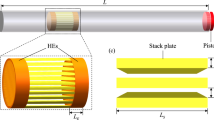Abstract
Fatigue crack propagation characteristics of a diesel engine crankshaft are studied by measuring the fatigue crack growth rate using a frequency sweep method on a resonant fatigue test rig. Based on the phenomenon that the system frequency will change when the crack becomes large, this method can be directly applied to a complex component or structure. Finite element analyses (FEAs) are performed to calibrate the relation between the frequency change and the crack size, and to obtain the natural frequency of the test rig and the stress intensity factor (SIF) of growing cracks. The crack growth rate i.e. da/dN-ΔK of each crack size is obtained by combining the testing-time monitored data and FEA results. The results show that the crack growth rate of engine crankshaft, which is a component with complex geometry and special surface treatment, is quite different from that of a pure material. There is an apparent turning point in the Paris’s crack partition. The cause of the fatigue crack growth is also discussed.
Similar content being viewed by others
References
Chien, W.Y., Pan, J., Close, D., Ho, S., 2005. Fatigue analysis of crankshaft sections under bending with consideration of residual stresses. International Journal of Fatigue, 27(1):1–19. [doi:10.1016/j.ijfatigue.2004.06.009]
Lee, S.Y., Song, J.H., 2000. Crack closure and growth behavior of physically short fatigue cracks under random loading. Engineering Fracture Mechanics, 66(3):321–346. [doi:10.1016/S0013-7944(99)00133-2]
Lin, X.B., Smith, R.A., 1999. Stress intensity factors for corner cracks emanating from fastener holes under tension. Engineering Fracture Mechanics, 62(6):535–553. [doi:10.1016/S0013-7944(99)00007-7]
Lin, X.B., Smith, R.A., 2001. Numerical Simulation of Fatigue Crack Growth for Corner Cracks Emanating from Fastener Holes. In: ie]Pluvinage, G., Gjonaj, M. (Eds.), Notch Effects in Fatigue and Fracture. Kluwer Academic Publisher, p.271–287.
Ochi, Y., Masaki, K., Matsumura, T., Sekino, T., 2001. Effect of shot-peening treatment on high cycle fatigue property of ductile cast iron. International Journal of Fatigue, 23(5):441–448. [doi:10.1016/S0142-1123(00)00110-9]
Sadananda, K., Vasudevanb, A.K., 2005. Fatigue crack growth behavior of titanium alloys. International Journal of Fatigue, 27(10–12):1255–1266. [doi:10.1016/j.ijfatigue.2005.07.001]
Silva, F.S., 2005. The importance of compressive stresses on fatigue crack propagation rate. International Journal of Fatigue, 27(10–12):1441–1452. [doi:10.1016/j.ijfatigue.2005.07.003]
Yu, V., Chien, W.Y., Choi, K.S., Pan, J., 2004. Testing and Modeling of Frequency Drops in Resonant Bending Fatigue Tests of Notched Crankshaft Sections. SAE TP 2004-01-1501.
Zhao, J., Miyashita, Y., Mutoh, Y., 2000. Fatigue crack growth behavior of 95Pb-5Sn solder under various stress ratios and frequencies. International Journal of Fatigue, 22(8):665–673. [doi:10.1016/S0142-1123(00)00065-7]
Author information
Authors and Affiliations
Corresponding author
Rights and permissions
About this article
Cite this article
Zhou, X., Yu, Xl. Fatigue crack growth rate test using a frequency sweep method. J. Zhejiang Univ. Sci. A 9, 346–350 (2008). https://doi.org/10.1631/jzus.A0720009
Received:
Accepted:
Published:
Issue Date:
DOI: https://doi.org/10.1631/jzus.A0720009




